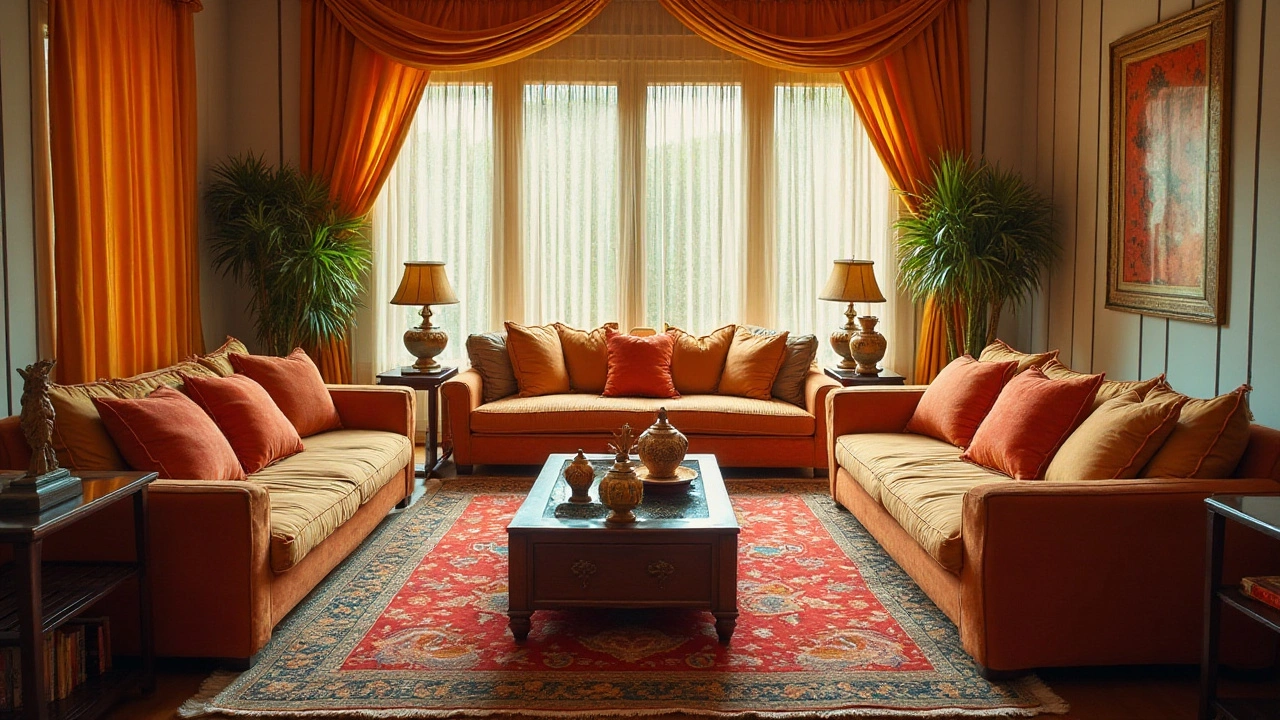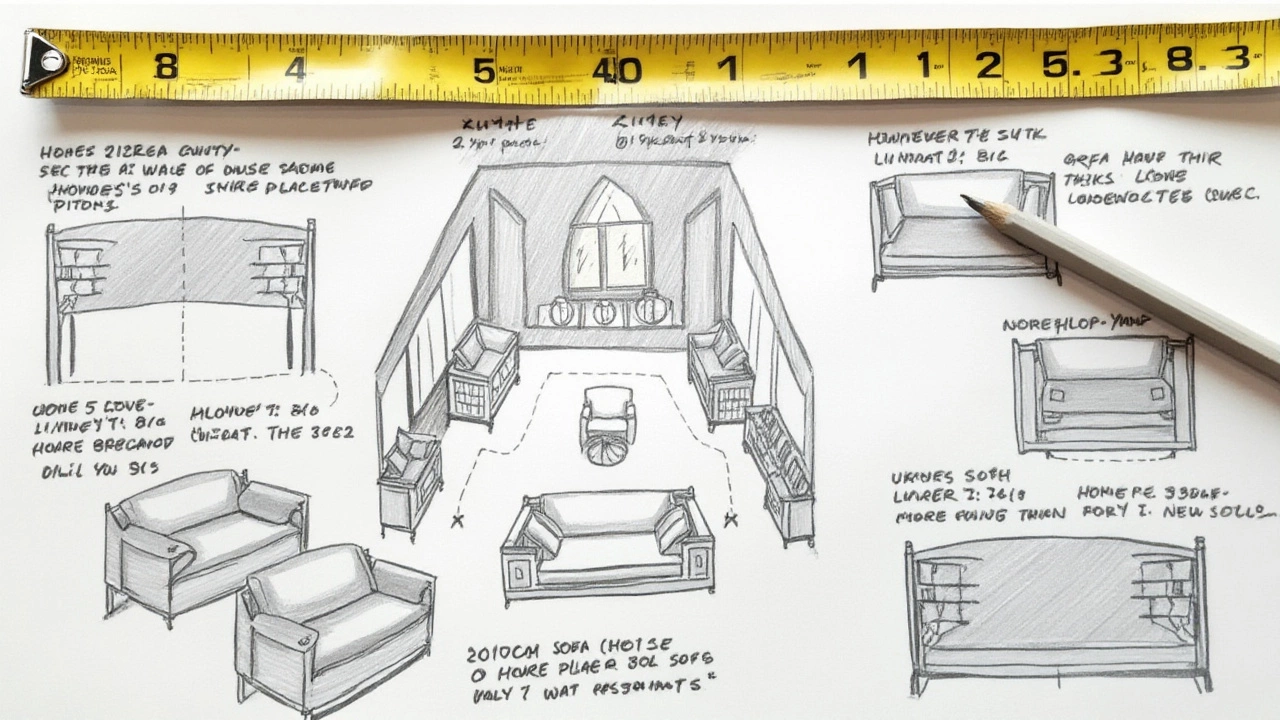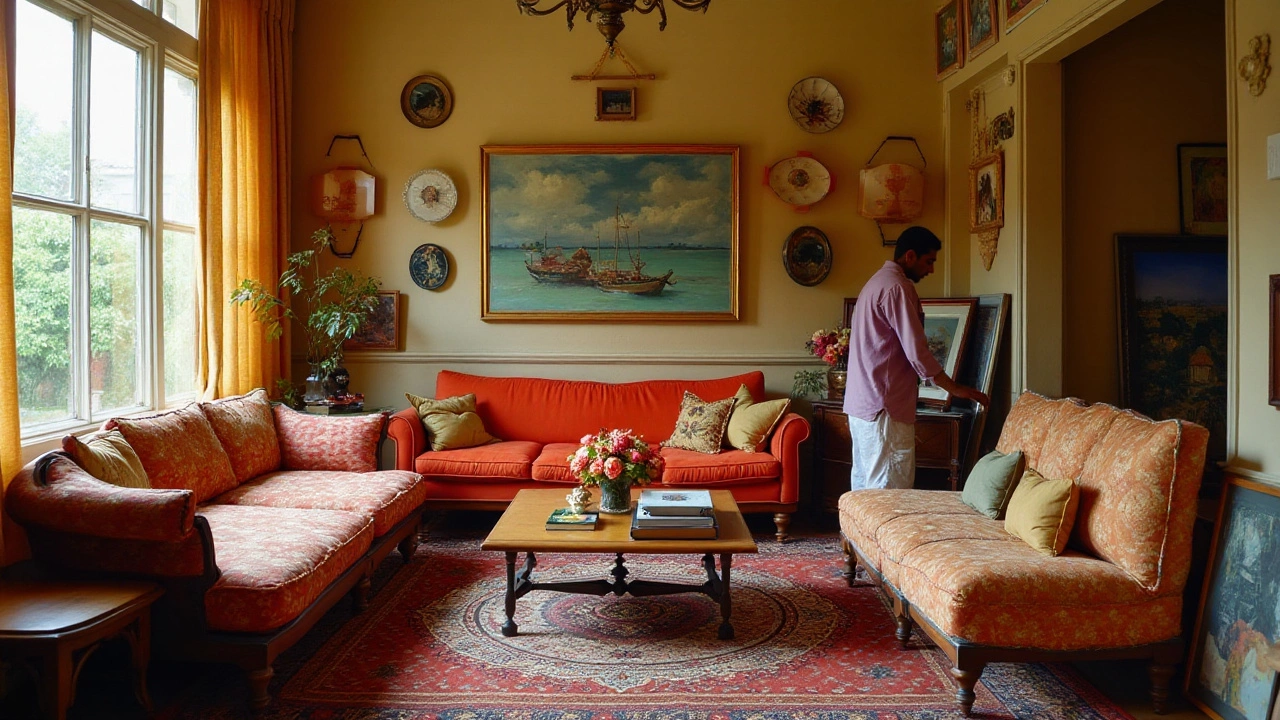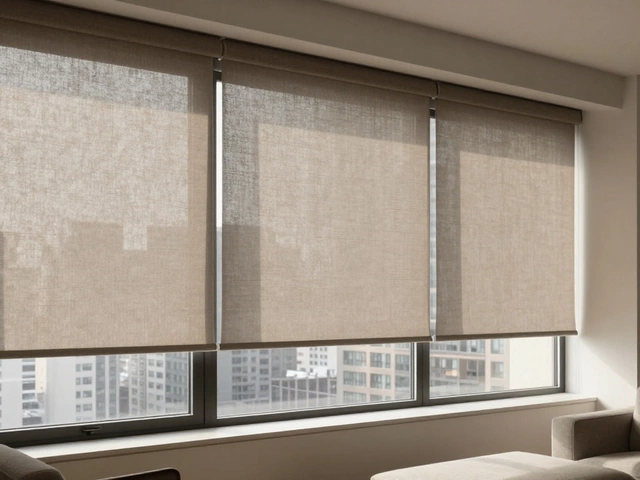
Picking the right sofa size is as crucial as finding a good pair of jeans—it has to fit just right. Sofas are often the centerpiece of living rooms, making them a vital piece of furniture in any home.
From compact loveseats to sprawling sectionals, sofa sizes vary significantly, catering to both small apartment corners and expansive open-plan living rooms. But how do we determine what size is the most popular and why?
This article will guide you through the maze of sofa dimensions, revealing which sizes are most favored today and offering practical tips to help you make the best choice for your home. Whether you're revamping your current setup or planning from scratch, understanding sofa sizing could save you from décor disasters.
- Understanding Sofa Sizes
- Factors Influencing Sofa Size Choice
- Popular Sofa Size Trends
- Tips for Choosing the Right Sofa Size
Understanding Sofa Sizes
The beauty of sofa sizes lies in their versatility. From snug loveseats designed for tight spaces to grand sectionals perfect for large families, there's a sofa to fit nearly every need and living space. The typical length of a standard sofa is around six to eight feet. However, sofas can range from compact 50-inch styles to expansive 120-inch sectionals. Each size caters to specific requirements and styles of living, which makes understanding your need paramount.
Loveseats, for example, are typically designed for two people and can range from 50 to 70 inches in width, making them ideal for cozy apartments or small office spaces. Slightly larger are three-seaters, often hitting the six-foot mark; these provide ample seating without overwhelming a room's proportions. Then there are sectionals, which can be configured in various ways, fully utilizing larger living areas. Their modular nature means they can stretch anywhere from 90 inches to upwards of 140 inches for a grand U-shape setup.
When browsing for the perfect sofa, consider not just the dimensions but also the layout of your room. In some cases, a large sectional can divide a space comfortably, particularly in open-plan homes where you might want to create distinct zones. However, if your home features narrow doorways or awkward corners, a smaller, more maneuverable design may be prudent. This also highlights the importance of considering your typical room traffic—do you need a sofa that will accommodate a growing family, or is it more for decorative purposes?
"A well-chosen sofa does more than just fill a room—it adds character and comfort to a home," renowned interior designer Sarah Richardson once emphasized.
The rise of customizable furniture has also influenced sofa sizes. Nowadays, many retailers offer modular options allowing you to build a sofa piece by piece, tailoring the size exactly to your preferences. This level of customization has become quite popular in contemporary design, providing flexibility that was not traditionally available.
Using Sofa Size to Maximize Space
Given the extensive range in sofa sizes, it's crucial to measure your space accurately before making a decision. Consider the room's scale and ensure your chosen furniture complements rather than dominates the area. Ideally, your sofa should leave enough room for movement and balance with coffee tables and side tables around it. Remember too much furniture can make a space feel cramped and cluttered, which is why a thoughtfully chosen size is key. A pro tip is to use painter's tape on your floor to outline the potential sofa footprint to help visualize how different sizes will fit within your space.

Factors Influencing Sofa Size Choice
Choosing the right sofa size involves more than just a quick measurement of your living room. There are several factors to take into account, with room layout being the starting point. The layout of your space dictates how a sofa will function and fit. For instance, an open-plan living area might accommodate a large sectional, creating a natural division of space. In contrast, a cozy apartment might only have room for a compact loveseat. When planning your seating arrangement, think about traffic flow—how people will move in and out of the space without obstruction—and don’t forget existing furniture that could affect positioning and size decisions.
Lifestyle is another influential factor. Consider how you use your living room. A family with young children might prioritize durability and stain resistance, alongside size, selecting a sofa that can handle everyday wear and tear. Those who frequently host gatherings might look for larger options, perhaps a sectional that can comfortably seat more guests. On the other hand, someone living solo might opt for a smaller, stylish sofa that matches their aesthetic requirements. Here, personal style and frequency of use align with size choices.
Beyond the internal considerations, sometimes insights come from external advice. Neal Zimmerman, a celebrated interior designer, highlights that "the scale of a sofa often dictates the room’s ambience... it can make a space feel inviting or overwhelmed." The market trends also exert influence; as smaller homes and apartments gain popularity in urban areas, so does the demand for smaller sofas. Compact sofas can also be more economically appealing and sustainable, catering to those conscious of space and environmental impact.
Material and depth should not be overlooked. The type of upholstery and its color can affect the perception of size. For example, lighter fabrics often make large sofas seem less imposing, while darker materials can add depth and weight. Similarly, a deeper seat might offer enhanced comfort but can eat up more space. This subtle balancing act between size and material can be key to creating the desired ambiance.
There’s also a practical side to these choices. Before purchasing, account for entryway measurements and stairway widths. Many have discovered, to their dismay, that their dream sofa won't fit through the door. Manufacturers often provide configurations that can be assembled inside the room itself, but it’s always smart to double-check. Preparation in this regard can eliminate future frustrations and ensure the sofa seamlessly becomes a part of your home without the hassle.

Popular Sofa Size Trends
The popularity of specific sofa sizes tends to be dictated by shifting lifestyle trends, room dimensions, and even cultural influences. Many urban dwellers have gravitated towards minimalist designs, prompting a surge in demand for compact, multi-functional sofas like loveseats and single-seater sofas. Their compact dimensions make them ideal for smaller apartments or multifunctional rooms. In fact, recent surveys across metropolitan areas have revealed that smaller sofas, often less than 60 inches wide, now account for a significant portion of sales among younger demographics striving to maximize their living areas without compromising on style.
Contrasting this trend, suburban homes have shown a steady preference for sectional sofas. These larger furnishings, typically exceeding 100 inches in length, cater to bigger family gatherings and entertainment spaces. With open-plan designs gaining popularity, these sofas serve as more than just seating—they become room dividers that help delineate living and dining areas. In a market analysis conducted by Home Décor Magazine, it was noted that families often opt for sectionals due to their flexibility and ability to accommodate various configurations, allowing homeowners to personalize their layout effectively.
"When designing a home, the sofa is a statement piece as much as it is a functional item," says interior designer and author Sarah Richardson. "Choosing the right size is not just about fitting it into your room—it's about complementing your lifestyle."
An emerging trend moving into 2025 is modular sofas, a preferred choice for those who value adaptability. These sofas strike a remarkable balance between size and function. With parts that can be moved and adjusted, they enable endless design possibilities, whether you need a cozy corner chair or a social space. This kind of flexibility is particularly attractive to tech-savvy millennials and Gen Z, who often prioritize versatility and customization in their furnishings.
For the environmentally conscious consumer, the trend leans towards sustainably produced sofas, where size considerations also play a part. Optimal use of materials means these sofas often come in moderate sizes, avoiding the excess typically seen in extravagantly cushioned designs. Not to mention, these choices resonate with the broader ecological drive that emphasizes reducing waste at every stage of a product's life cycle. Curiously, while sustainability is now influencing the materials and production methods, it similarly impacts sofa dimensions, subtly nudging consumers toward the more efficient end of the scale.
Couch dimensions matter hugely when you're aiming for both aesthetic appeal and practical functionality. A study conducted by the American Furniture Retail Weekly highlighted that purchasing trends are increasingly influenced by people's growing awareness of how living room furniture impacts their quality of life. From maximizing seating in compact spaces with versatile layouts to turning grand living areas into luxurious lounges, choosing the right size ensures that the sofa does not just fill a room—it's an integral part of your living experience.

Tips for Choosing the Right Sofa Size
Choosing the right sofa size is a task that intertwines practicality with aesthetics, and each aspect holds equal weight. The first consideration must always be the room's dimensions. Measure your living room carefully before stepping into a showroom or browsing online. Consider the space you need for walking around the sofa, opening doors, and accessing other furniture pieces without bumping your toes. Space planners often suggest leaving about 18 inches between the sofa and the coffee table to ensure comfortable circulation. Technology has made this easier, with plenty of apps allowing you to visualize your room layout through augmented reality.
Another pivotal factor is how the sofa size aligns with your lifestyle. If you often entertain guests, investing in a larger sectional can turn your living space into a social hub, ensuring everyone has a seat during movie nights or casual meet-ups. But if your home is a sanctuary for solitude, a compact loveseat might suffice. Families with young kids may consider deeper sofas with soft linen that can gracefully handle spills. Striking a balance between your lifestyle and the sofa’s dimensions is key. Experts from interior design suggest matching family needs to furniture sizes, emphasizing the importance of practicality.
Measure Before You Buy
Accurate measurement is your best friend when deciding on the perfect couch dimensions. Avoid estimation errors by measuring in multiple ways. Using painters' tape to outline the sofa’s footprint on the floor can give a real sense of its presence in the room. Consider not only the space it occupies on the floor but also its height, especially in rooms with low ceilings or ornate wall features. Then, measure your doorways, hallways, staircases, and any other potential obstacles in the sofa's journey into your house. The last thing you want is to fall in love with a piece that can't even make it through your front door!
Once you have the measurements down, don’t shy away from reaching out to professionals. A designer’s eye can provide insights the untrained eye might miss. However, tools like design software for home planning can also be an invaluable resource for those DIY enthusiasts who enjoy the chance to experiment with different layouts and sofa size options without moving an inch of real furniture.
Scale and Proportion
When it comes to furniture, scale and proportion are essential design principles that determine harmony within a space. A tiny loveseat might look dwarfed in a grand room with high ceilings, while a grand sectional can feel overwhelmingly bulky in a compact apartment. It’s not just about filling the space but enhancing it. Scale helps create balance, ensuring no single piece of furniture overwhelms the room. Proportion, meanwhile, coax symmetry, guiding you in pairing a sofa with complementary pieces—think side tables or armchairs—in proportionate sizes.
A well-known designer once stated, 'In any home, the decision starts with the sofa. It sets boundaries for decorating across every element, from curtains to artwork, guiding the room’s story.'
Explore the way your current or future pieces fit into the room’s story. By using larger pieces sparingly, and ensuring essential movement paths remain clear, better harmony is achieved.
Budget and Material
Finally, any sofa size choice is bound by budget. Larger designs with integrated recliners or modular options will often come with a heftier price tag. Consider not just the initial cost, but potential maintenance—upholstery may be prone to wear, and steam cleaning larger sofas can stack up bills over the years. Yet, investing in durable materials like leather or high-quality microfiber might cost more upfront but pay off in longevity. Conduct a thorough cost-benefit analysis based on your financial plans and the living room furniture peace of mind.
These considerations ensure you not only select the ideal sofa but that it feels just as good as it looks, easily becoming the throne of your living room kingdom.




